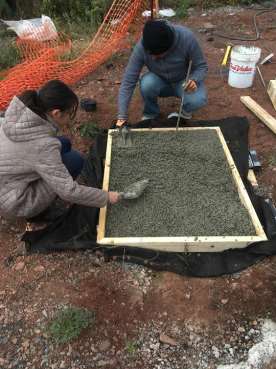NJDOT Research
 Pervious concrete have been increasing in popularity as a potential solution to reduce the amount of impermeable surface area associated with sidewalks, reduce puddling, and potentially slow storm water surface high flow rates. As important as these benefits are to surface runoff mitigation, there are concerns with the ability of pervious concrete mixes to provide sufficient structural support and longevity for the expected service life of the sidewalks as well as life cycle costs.
Pervious concrete have been increasing in popularity as a potential solution to reduce the amount of impermeable surface area associated with sidewalks, reduce puddling, and potentially slow storm water surface high flow rates. As important as these benefits are to surface runoff mitigation, there are concerns with the ability of pervious concrete mixes to provide sufficient structural support and longevity for the expected service life of the sidewalks as well as life cycle costs.
The composition of pervious concrete creates limitations to its mechanical strength and challenges in its maintenance to achieve the expected service life. The performance of pervious concrete pavements is relevant to its geographical location and application as well. Eleven different pervious concrete mix designs that include commercially available mixes as well as laboratory designed mixes were evaluated in this study. Mechanical properties such as compressive strength, flexural strength, splitting tensile strength, and elastic modulus were measured. Shrinkage and freeze and thaw properties were also evaluated. The study also evaluated hydraulic conductivities using the falling head and constant head test methods. A life cycle cost analysis was performed to evaluate the cost-benefit of using pervious concrete in sidewalks. Conventional and previous concrete field slabs were cast and tested for thermal and radiation performance. Compressive strength values varied from 1100 to 3400 psi at 28 days while those for the modulus of rupture were between 150 to 370 psi. Hydraulic conductivities were between 0.04 to 0.06 cm/sec and elastic modulus values were between 1000 to 2800 ksi. Freeze and thaw tests up to 100 cycles showed about 6% loss of mass. The vibration and placement methods have an impact of the mechanical and hydrological properties.
The life cycle cost analysis showed that that the initial construction cost of porous concrete is slightly greater than that of conventional concrete for sidewalks without subsurface drainage systems. The initial construction cost of porous asphalt sidewalks is lower than those of conventional concrete sidewalks. When the service life ratio of porous asphalt compared to conventional concrete is greater than 0.60, the porous asphalt would be the most economically competitive option compared to porous concrete and conventional concrete.
Posted in Uncategorized.
